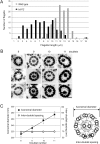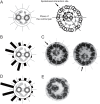Space-dependent formation of central pair microtubules and their interactions with radial spokes
- PMID: 25333940
- PMCID: PMC4204893
- DOI: 10.1371/journal.pone.0110513
Space-dependent formation of central pair microtubules and their interactions with radial spokes
Abstract
Cilia and flagella contain nine outer doublet microtubules and a pair of central microtubules. The central pair of microtubules (CP) is important for cilia/flagella beating, as clearly shown by primary ciliary dyskinesia resulting from the loss of the CP. The CP is thought to regulate axonemal dyneins through interaction with radial spokes (RSs). However, the nature of the CP-RS interaction is poorly understood. Here we examine the appearance of CPs in the axonemes of a Chlamydomonas mutant, bld12, which produces axonemes with 8 to 11 outer-doublets. Most of its 8-doublet axonemes lack CPs. However, in the double mutant of bld12 and pf14, a mutant lacking the RS, most 8-doublet axonemes contain the CP. Thus formation of the CP apparently depends on the internal space limited by the outer doublets and RSs. In 10- or 11-doublet axonemes, only 3-5 RSs are attached to the CP and the doublet arrangement is distorted most likely because the RSs attached to the CP pull the outer doublets toward the axonemal center. The CP orientation in the axonemes varies in double mutants formed between bld12 and mutants lacking particular CP projections. The mutant bld12 thus provides the first direct and visual information about the CP-RS interaction, as well as about the mechanism of CP formation.
Conflict of interest statement
Figures




References
-
- Badano JL, Mitsuma N, Beales PL, Katsanis N (2006) The ciliopathies: an emerging class of human genetic disorders. Annual review of genomics and human genetics 7: 125–148. - PubMed
-
- Onoufriadis A, Shoemark A, Schmidts M, Patel M, Jimenez G, et al. (2014) Targeted NGS gene panel identifies mutations in RSPH1 causing primary ciliary dyskinesia and a common mechanism for ciliary central pair agenesis due to radial spoke defects. Human molecular genetics 23: 3362–3374. - PMC - PubMed
Publication types
MeSH terms
Substances
LinkOut - more resources
Full Text Sources
Other Literature Sources
Miscellaneous

